2:53 pm
Ghadames, Libya
Unlikely as it seemed at the outset, Ghadames just may be my favorite city so far. Reason #1: We've just returned to the hotel for a siesta, because the whole town shuts down until the evening to escape the afternoon heat. That's my kind of thinking.
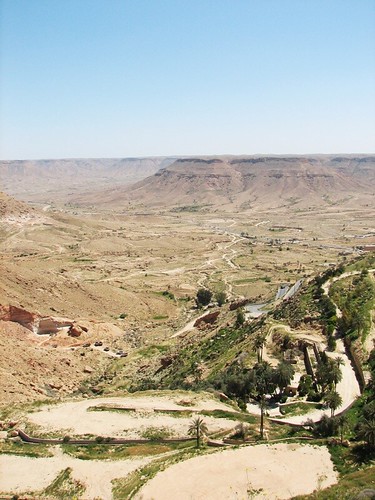
The drive here yesterday from Tripoli was long, but not so arduous. To break up the journey, we made a couple of stops: an old granary and the little town of Nalut. Both had remarkably preserved and intricately constructed granaries, little storerooms built one on top of each other giving the overall effect of a giant anthill. Traditional Berber mud architecture, but it looked like a big sand dune with holes. I climbed up to peek inside the dark chambers, and some still contained amphoras, the large clay storage jars.
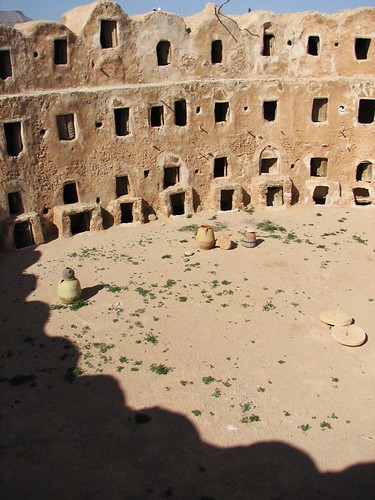
Qasr al-Haj

Nalut
The stretch of road between Nalut and Ghadames gave us our first real glimpse of the desert, the Grand Erg Oriental. These region is called the Jebel Nafusa. Rippling piles of sand, sun bleached plateaus, smatterings of palm trees around scant oases. And, several herds of stubborn camels crossing the road, stopping traffic. Watching a spooked camel gallop out of the way of a blaring horn never failed to amuse.

Mohammed leaving our hotel
We arrived in Ghadames at about 6:15 pm. The majority of the town shares the mudbrick architecture of the sites we saw en route. I've never really been to the southwest, but a number of people compared the two, especially the terrain. Our hotel just opened six months ago, part of The Colonel's directive to increase tourism. It's lovely here, not only clean and liveable (no saran wrap needed), but comfortable and architecturally interesting. Meant to mimic the style of the old city.
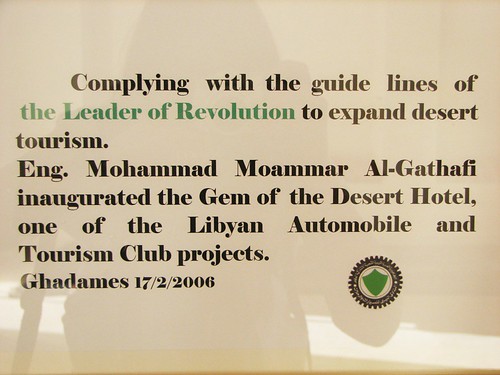
Which it does to a tee. This morning, after a visit to the Ghadames Museum and some requisite shopping, we walked through the labyrinth of covered mud brick walls and alleys that comprise the Old City. The entire area is a UNESCO World Heritage site. No one lives there now (though it was inhabited until just two or three years ago by a woman who insisted she was born there, she was going to die there). But, the homes are still privately owned and it's used as a retreat from the summer heat. Outer walls are about a meter thick, 90% of the spaces are covered, with just a few slots for light, so it feels air-conditioned.
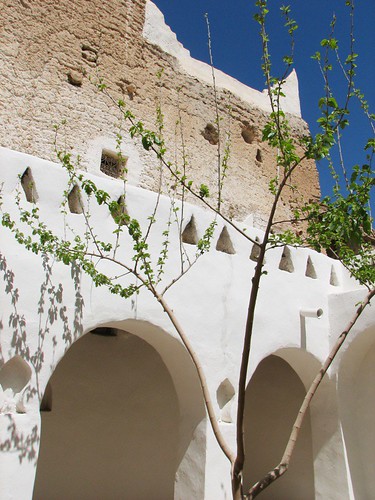
Courtyard at Ghadames
It's really a visually amazing place -- emphasis on maze. Benches are built right into and of the same mud brick as the walls along the "streets", as are the bed platforms and tables in our hotel. There are mosques, schools, and meeting places. Daily life was incredibly, almost shockingly segregated (as it still is today... had to check my principles at the door). Regarding publicspaces, only men are allowed at the mosques and in the meeting places; women are confined to the top floor and THE ROOF. (Except for designated times at the mosque, where I think I heard our guide say their main purpose was to clean.)

Our lunch was a surprise. Rather than stopping at restaurant as usual, we were led to a fully decorated traditional home, still in use (at least as a tourist stop), with carpets and pillows lining the floor, mirrors, baskets, tapestries and other handicraft adorning the walls right up to the ceiling.

We sat on the cushioned floor to eat, and our meal was brought out on large round silver trays with legs. Five to a tray. One of the local craft specialities are these brightly woven conical food covers, though they look more like little hats to me, so we got to see them in action. They're almost too pretty to use. Cousous and veggies (and lamb for the omnivores). It was so fantastic! One of the more "authentic" experiences yet.
Followed closely by my donning of the traditional Tuareg head scarf. I bought one at one of the many shops in the old city, thinking I'd give it to someone, but Salem (our security guy, pronounced "solemn", not like the cigarette) insisted on wrapping it up for me. It was kind of awesome, I'm digging the look. He was also wearing a scarf so we struck a pose for the cameras. I think all the old ladies in our group are crushing on him and his tight pants. He's becoming my homie on this trip, despite speaking about six words of English. Then the tables turned, and Libyans were taking pictures of ME. We ran into a group of teenage boys and all wanted their photo with me. Very cute. I would see them again later that evening.
As we wound our way through the districts of the old city, we'd pass a Japanese group every so often, filing past each other like opposing baseball teams exchanging forced pleasantries. I said konnichi wa and two ladies got all excited and held up the line.
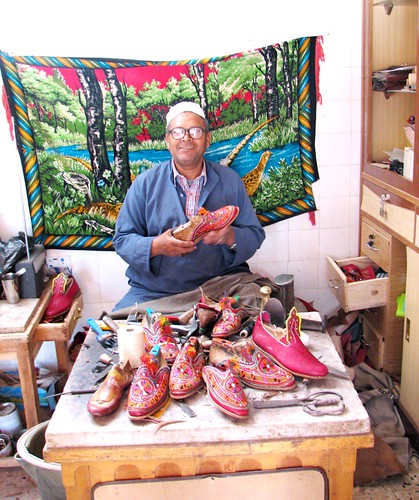
Shoemaker in the shops
Then, at one of the many, many shopping stalls, we met a little boy named Mohammed, probably about two or three and the son of the craftsman. I got all Angelina Jolie and kind of wanted to take him home with me. The biggest brown eyes you've ever seen. Didn't make a sound, didn't move an inch. My kind of kid.
Now we are about to head out into the Sahara via 4x4 Jeeps to visit a haunted castle and watch the sunset. After that, it's dinner and a dance performance. I'm amped.
1 comment:
very good condition, especially given it's continued level of use. some areas are under renovation, so there's definitely an effort to maintain the site.
ghadames was one of five UNESCO sites i visited... the others were abu mena in egypt; and cyrene, sabratha, leptis magna, and the rock art of the acacus mountains in libya.
Post a Comment